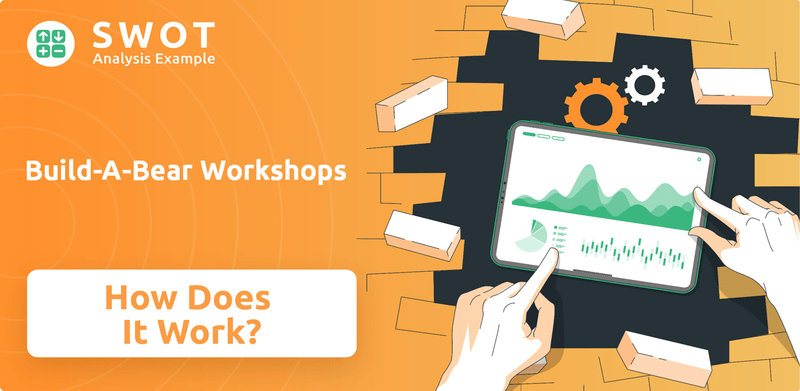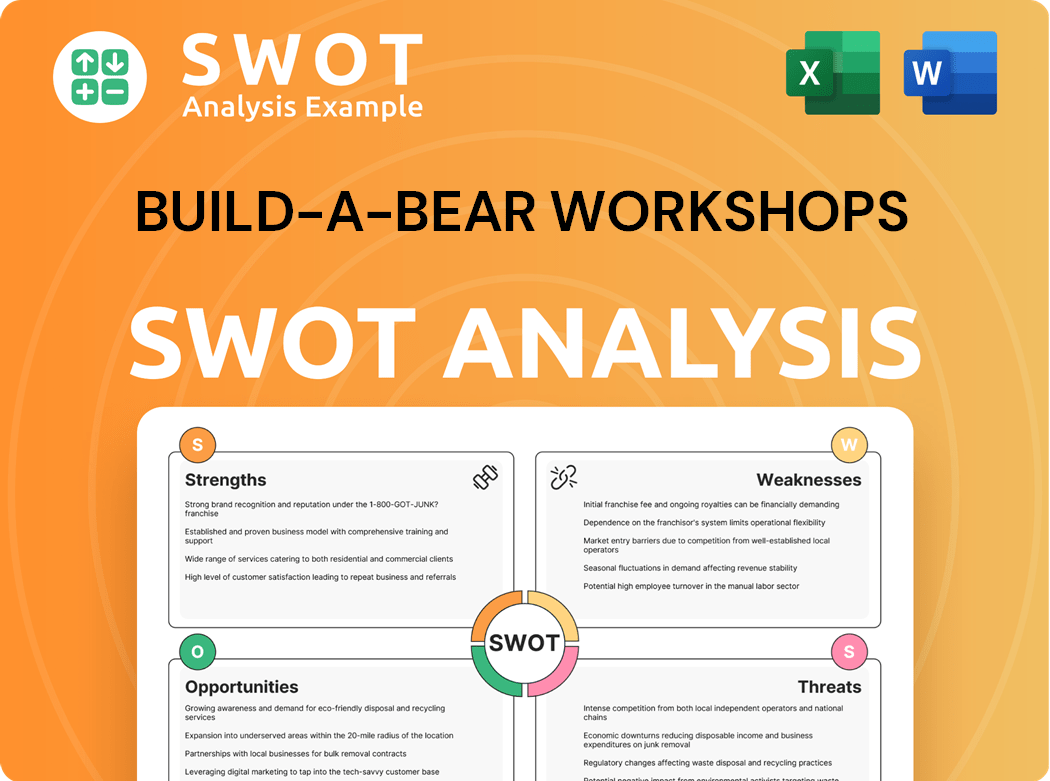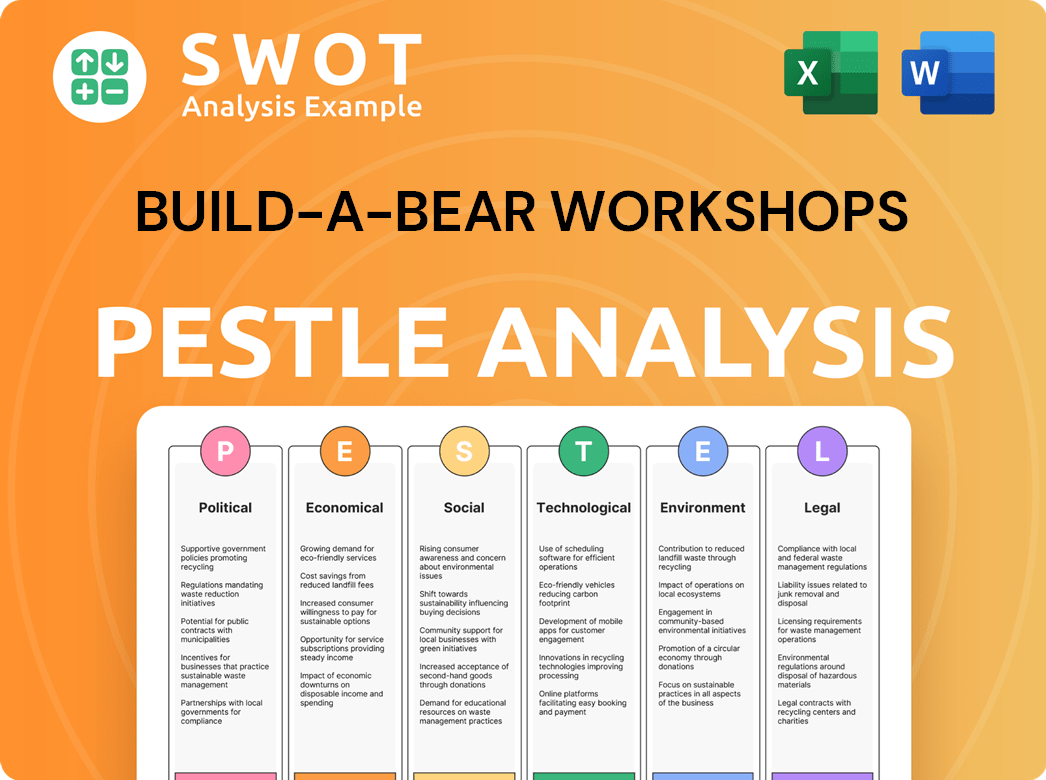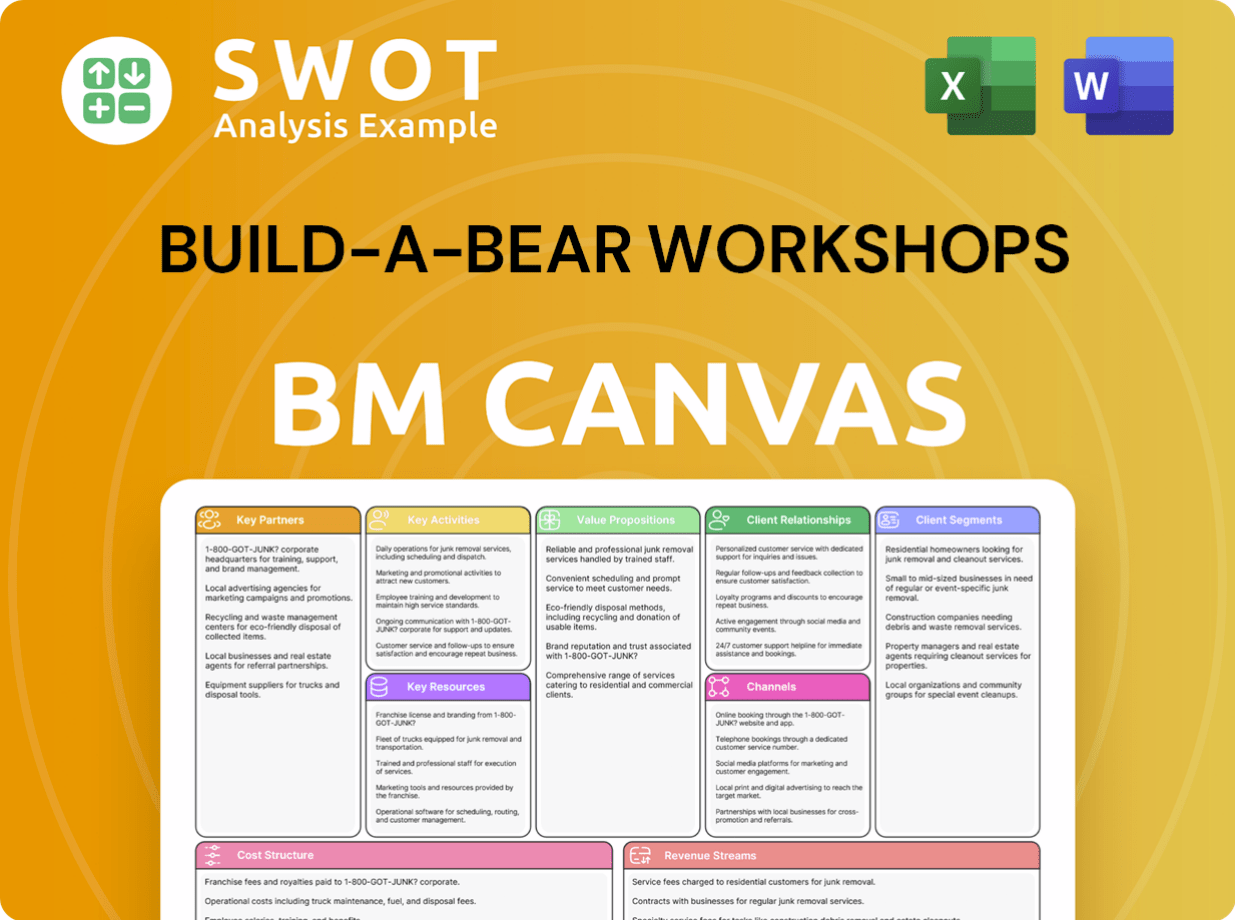Build-A-Bear Workshops Bundle
How Does Build-A-Bear Workshop Thrive in Today's Retail World?
Step into a world where retail transforms into a cherished memory – welcome to Build-A-Bear Workshop, a company that redefined the toy industry. Imagine a place where customers don't just buy a toy, but actively participate in creating a personalized companion. This innovative approach has not only captivated generations but also propelled Build-A-Bear to achieve remarkable financial success.

This article dives deep into the Build-A-Bear Workshops SWOT Analysis, exploring the operational heart of Build-A-Bear, from the unique Build-A-Bear experience to its diverse revenue streams and strategic advantages. Discover how Build-A-Bear Workshop has consistently delivered impressive financial results and adapted its business model to thrive in the dynamic retail landscape. Whether you're curious about stuffing a bear, the Build-A-Bear process, or seeking Build-A-Bear gift ideas, this analysis provides a comprehensive look at this enduring brand.
What Are the Key Operations Driving Build-A-Bear Workshops’s Success?
The core of the Build-A-Bear Workshop's success lies in its interactive and personalized approach to creating stuffed animals. The Build-A-Bear experience centers around the 'Bear Builder' process, where customers actively participate in customizing their furry friends. This hands-on approach fosters an emotional connection, setting it apart from traditional toy retailers.
Build-A-Bear Workshop caters to a diverse customer base, including children, teens, and adults, offering a unique experience that goes beyond simply purchasing a toy. The company's value proposition focuses on providing a memorable and engaging activity, where customers can choose from a variety of animals, stuffing options, sounds, scents, outfits, and accessories, culminating in a personalized birth certificate. This customization drives customer loyalty and repeat visits.
Operationally, Build-A-Bear Workshop employs an omnichannel retail strategy, combining physical stores with a robust online platform. As of May 2025, the company had a global presence with 604 locations. This includes direct-to-consumer stores, wholesale locations, and royalty-based models, demonstrating a strategic approach to market expansion and revenue diversification.
The Build-A-Bear process involves eight interactive stations. Customers choose an animal, stuff it, add sounds and scents, select outfits and accessories, and receive a birth certificate. This interactive experience is a key differentiator, making it more than just a purchase.
Build-A-Bear operates through physical stores and an online platform. This allows customers to create and order custom stuffed animals both in-store and online. This strategy ensures accessibility and convenience for customers.
Build-A-Bear is actively expanding its footprint, with plans to open at least 50 new locations in fiscal 2025. The company utilizes an 'asset-light,' partner-operated model. Partnered locations contributed 25% of pre-tax income in fiscal 2024.
The company focuses on delivering customer satisfaction through a trained workforce. Strategic partnerships for co-branded products create a significant barrier to entry for potential competitors. The Build-A-Bear experience is designed to create lasting memories.
Build-A-Bear Workshop's operational model combines in-store experiences with online sales. The company sources a significant portion of its merchandise from a few vendors. The focus on customer interaction and personalization is central to its success.
- The 'Bear Builder' process is the core of the Build-A-Bear experience.
- The company has expanded its locations, with 604 global locations as of May 2025.
- Partnerships play a crucial role in the company's expansion strategy.
- The company's customer-centric approach creates a strong brand loyalty.
Build-A-Bear Workshops SWOT Analysis
- Complete SWOT Breakdown
- Fully Customizable
- Editable in Excel & Word
- Professional Formatting
- Investor-Ready Format

How Does Build-A-Bear Workshops Make Money?
The revenue streams and monetization strategies of Build-A-Bear Workshop are diverse, encompassing various channels to maximize profitability. The company's approach includes direct-to-consumer sales, commercial ventures, and international franchising, each contributing significantly to its financial performance. These strategies have allowed Build-A-Bear to adapt and grow, attracting a wide customer base.
Build-A-Bear's primary revenue source is its direct-to-consumer (DTC) sales, which are generated through retail stores and e-commerce platforms. Complementing this, Build-A-Bear has expanded into commercial and international franchise segments, which have shown substantial growth. These additional revenue streams help to diversify the company's income and enhance its market position.
Build-A-Bear's DTC sales reached $460.32 million in fiscal year 2024, representing the largest portion of its total revenue of $496.4 million. The commercial segment, along with international franchise revenues, experienced a notable increase of 20.5% in both the fourth quarter and the full fiscal year 2024. In the first quarter of fiscal 2025, the combined revenues from commercial and international franchises increased by 28.3% to $8.8 million.
DTC sales are the cornerstone of Build-A-Bear's revenue model, encompassing retail stores and e-commerce. This segment generated $460.32 million in fiscal year 2024, demonstrating its importance to the company's overall financial health. The success of DTC sales highlights the enduring appeal of the Build-A-Bear experience.
The commercial segment involves sales to other businesses, including wholesale product sales and licensing agreements. This area, along with international franchising, showed significant growth, increasing by 20.5% in both the fourth quarter and the full fiscal year 2024. This diversification supports the company's revenue streams.
International franchising contributes through development fees, royalties, and sales of merchandise to franchisees. The combined revenue from commercial and international franchise segments increased by 28.3% to $8.8 million in the first quarter of fiscal 2025. This expansion indicates the brand's global reach.
Build-A-Bear employs tiered pricing for customization and cross-selling of accessories to enhance revenue. The 'Birthday Treat Bear' promotion, for example, makes the Build-A-Bear experience accessible. The company has also expanded into outbound licensing and content creation to diversify its income sources.
E-commerce has become a significant part of Build-A-Bear's sales, accounting for 20% of sales, up from 5% in 2012. This growth reflects the company's adaptation to changing consumer preferences. This shows the company's success in the online market.
Approximately 40% of sales now come from teens and adults, a notable increase from 25% at the start of CEO Sharon Price John's tenure. This shift demonstrates the brand's ability to attract a broader demographic. The company has successfully expanded its customer base.
Build-A-Bear utilizes several strategies to boost revenue, including tiered pricing and cross-selling. These tactics enhance the customer experience and increase sales. The company's focus on customization and accessories is a key part of the Build-A-Bear process.
- Tiered Pricing: Offers flexibility and caters to different budgets.
- Cross-selling: Encourages additional purchases of outfits and accessories.
- Licensing and Content Creation: Generates royalty revenue and expands brand presence.
- E-commerce and Digital Sales: Provides convenient options for customers.
For a deeper understanding of the competitive landscape, explore the Competitors Landscape of Build-A-Bear Workshops.
Build-A-Bear Workshops PESTLE Analysis
- Covers All 6 PESTLE Categories
- No Research Needed – Save Hours of Work
- Built by Experts, Trusted by Consultants
- Instant Download, Ready to Use
- 100% Editable, Fully Customizable

Which Strategic Decisions Have Shaped Build-A-Bear Workshops’s Business Model?
The Growth Strategy of Build-A-Bear Workshops has been marked by significant milestones and strategic shifts. The company has evolved from a primarily retail-focused model to a branded intellectual property company, driving diverse revenue streams. This strategic pivot has led to consistent financial success, with four consecutive years of record revenues and pre-tax income since the pandemic.
In fiscal 2024, the company demonstrated robust financial performance, reporting total revenues of $496.4 million and a pre-tax income of $67.1 million. This represents a 1.2% increase, showcasing the effectiveness of its strategic initiatives. Key moves include expanding its global retail presence, focusing on partner-operated models, and increasing shareholder value through dividends.
Operational challenges, such as supply chain issues and tariffs, have been addressed through proactive measures, including accelerating purchases of core products. Build-A-Bear's competitive advantages are rooted in its strong brand recognition and unique in-store experience, which creates an emotional connection with customers. The ability to offer customization, along with its omnichannel retail strategy, further strengthens its market position.
The company has achieved consistent financial growth, with four consecutive years of record revenues and pre-tax income. Expansion of its global retail footprint is a key strategy, with plans to open at least 50 new locations in fiscal 2025. The company increased its dividend by 10% to $0.22 per share in March 2025.
Expanding its global retail footprint, with a focus on partner-operated models. The company is also expanding its brand through licensing agreements and content creation via Build-A-Bear Entertainment. A new, multilevel retail experience is planned for ICON Park in Orlando, Florida, set to open in 2026.
Strong brand recognition and a unique interactive in-store experience. The ability to customize products with sounds, scents, accessories, and names creates a significant barrier to entry. The company leverages its brand through licensing and digital innovation to enhance its online platform.
In fiscal 2024, the company reported total revenues of $496.4 million. Pre-tax income for fiscal 2024 was $67.1 million, a 1.2% increase. Partner-operated locations accounted for 25% of pre-tax income in fiscal 2024.
The company faced challenges related to supply chain issues, including freight costs and inventory transportation, and the impact of tariffs. To mitigate these, Build-A-Bear accelerated purchases of 2025 core products, leading to a 9.9% increase in inventory at year-end fiscal 2024, totaling $69.8 million.
- Navigating supply chain disruptions to maintain product availability.
- Managing the impact of tariffs on products manufactured in China.
- Proactively managing inventory levels to meet customer demand.
- Focusing on partner-operated models to reduce operational costs.
Build-A-Bear Workshops Business Model Canvas
- Complete 9-Block Business Model Canvas
- Effortlessly Communicate Your Business Strategy
- Investor-Ready BMC Format
- 100% Editable and Customizable
- Clear and Structured Layout

How Is Build-A-Bear Workshops Positioning Itself for Continued Success?
Build-A-Bear Workshop holds a distinct market position within the specialty retail and toy industry. The company's interactive, customer-centric experience and strong brand recognition contribute to a loyal customer base. Build-A-Bear has a significant global reach, operating in more than 30 countries with over 600 locations as of May 2025.
Despite its strengths, Build-A-Bear faces risks tied to discretionary consumer spending, supply chain issues, and competition within the toy industry. Economic factors, such as inflation and consumer confidence, can impact sales. The company's reliance on brand licensors and its e-commerce platform are also important considerations.
Build-A-Bear Workshop is a leader in the personalized toy segment. The company has a substantial market share of 62% in the custom stuffed animals market. The unique Build-A-Bear experience, including the stuffing a bear process, sets it apart from competitors.
The company is sensitive to changes in consumer spending and economic conditions. Supply chain disruptions, including freight costs and potential tariffs, pose risks to profitability. Dependence on brand licensors and the need to maintain a robust e-commerce platform are also important factors. The toy industry is highly competitive, with evolving consumer preferences.
Build-A-Bear Workshop is focused on sustaining and expanding profitability. The company anticipates mid-single-digit revenue growth for fiscal 2025. They plan to open at least 50 new locations globally in fiscal 2025, with a focus on partner-operated models. Capital expenditures are projected to be between $20 million and $25 million.
The company is investing in its digital platform to enhance customer engagement and streamline the purchasing process. Build-A-Bear is evolving its business model to leverage the brand's power, expanding beyond retail stores. This includes e-commerce, non-plush branded consumer categories, and content creation through Build-A-Bear Entertainment. For more insights, check out the Marketing Strategy of Build-A-Bear Workshops.
Build-A-Bear is expanding its global footprint and enhancing its digital presence to drive growth. The company is focusing on strategic partnerships and new product offerings to engage customers. The Build-A-Bear process and the Build-A-Bear experience continue to be central to the brand.
- Expansion of partner-operated locations to minimize capital risk.
- Investment in digital platforms and e-commerce capabilities.
- Development of new branded consumer categories.
- Focus on content creation to engage customers.
Build-A-Bear Workshops Porter's Five Forces Analysis
- Covers All 5 Competitive Forces in Detail
- Structured for Consultants, Students, and Founders
- 100% Editable in Microsoft Word & Excel
- Instant Digital Download – Use Immediately
- Compatible with Mac & PC – Fully Unlocked

Related Blogs
- What are Mission Vision & Core Values of Build-A-Bear Workshops Company?
- What is Competitive Landscape of Build-A-Bear Workshops Company?
- What is Growth Strategy and Future Prospects of Build-A-Bear Workshops Company?
- What is Sales and Marketing Strategy of Build-A-Bear Workshops Company?
- What is Brief History of Build-A-Bear Workshops Company?
- Who Owns Build-A-Bear Workshops Company?
- What is Customer Demographics and Target Market of Build-A-Bear Workshops Company?
Disclaimer
All information, articles, and product details provided on this website are for general informational and educational purposes only. We do not claim any ownership over, nor do we intend to infringe upon, any trademarks, copyrights, logos, brand names, or other intellectual property mentioned or depicted on this site. Such intellectual property remains the property of its respective owners, and any references here are made solely for identification or informational purposes, without implying any affiliation, endorsement, or partnership.
We make no representations or warranties, express or implied, regarding the accuracy, completeness, or suitability of any content or products presented. Nothing on this website should be construed as legal, tax, investment, financial, medical, or other professional advice. In addition, no part of this site—including articles or product references—constitutes a solicitation, recommendation, endorsement, advertisement, or offer to buy or sell any securities, franchises, or other financial instruments, particularly in jurisdictions where such activity would be unlawful.
All content is of a general nature and may not address the specific circumstances of any individual or entity. It is not a substitute for professional advice or services. Any actions you take based on the information provided here are strictly at your own risk. You accept full responsibility for any decisions or outcomes arising from your use of this website and agree to release us from any liability in connection with your use of, or reliance upon, the content or products found herein.